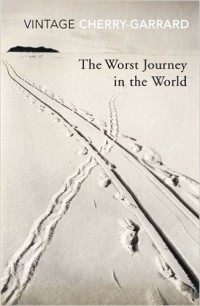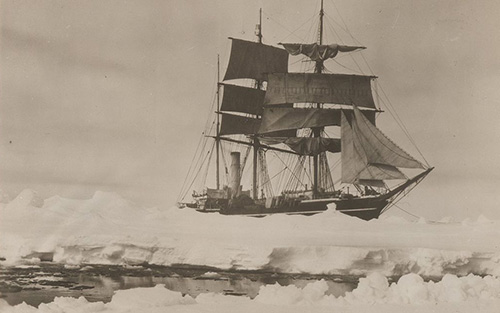A man is no better for having made the worst journey in the world
 The Worst Journey in the World
The Worst Journey in the World
by Apsley Cherry-Garrard
Wow. Just wow. Perhaps I’m biased by my pre-existing fascination with polar exploration, but this is an incredible book. Or rather, it reaches the very limits of credibility but does not overstep them, for I do not think that Cherry exaggerates at all. Humans beings have been through worse at the hands of other human beings, but not at the hands of nature.
This is a big book, but I tore through it in less than a week, foregoing most of my television and internet-pottering time because I just had to get back to this gripping story. For a day after finishing it I was reluctant to start another book or experience any other story. I wanted to sit with this tale of hardship and suffering in the name of science, of men who willingly endured that humankind might benefit. It is inspiring.
That is the main point that Cherry returns to time and again – that Captain Scott’s expeditions to Antarctica were first and foremost about science. Of course, Scott’s final journey, Cherry’s first and only Antarctic journey, was tragic and therefore legendary, but it is notable and commendable that it is not the deaths of Scott and the rest of the Polar Party that end this book. It is, rather, the safe return of the rest of the men and all their scientific observations and specimens.
“The atmosphere of hero-worship into which we were plunged on our return…was very agreeable; but it was a refracting medium through which the expedition could not be seen with scientific accuracy – and the expedition was nothing if not scientific. Whilst we knew what we had suffered and risked better than anyone else, we also knew that science takes no account of such things; that a man is no better for having made the worst journey in the world; and that whether he returns alive or drops by the way will be all the same a hundred years hence if his records and specimens come safely to hand.”
I should backtrack a little for those less familiar with the story. Apsley Cherry-Garrard was young – just 24 – when he joined the scientific team on the Terra Nova, a great 1910–1913 expedition to Antarctica led by Robert Falcon Scott with several scientific aims. One of these was to reach the South Pole, which had not yet been done and was therefore an extension of geographic knowledge.
Another aim – a particular drive for “Bill” Wilson, the expedition’s chief scientist – was to collect Emperor penguin eggs to study and it was for this specifically that Cherry was recruited. It involved a six-week nightmarish slog hundreds of miles in the darkness of the Antarctic winter to reach the eggs at the right time and the three men who undertook it (Cherry, Wilson and “Birdie” Bowers) came perilously close to death.
A third party of men were landed further around the coast to undertake geological work and when the ship could not get back through the ice to collect them the following summer they faced near-starvation (not having taken supplies for two winters) and had no means of getting a message to their colleagues at Cape Evans, where the Main Party were. In addition to all this there were daily magnetic, geological, zoological and meteorological observations that were carefully logged.
“To visualise the Antarctic as a white land is a mistake, for, not only is there much rock projecting…but the snow seldom looks white, and if carefully looked at will be found to be shaded with many colours…When to the beautiful tints in the sky and the delicate shading on the snow are added perhaps the deep colours of the open sea, with reflections from the ice foot and ice cliffs in it, all brilliant blues and emerald greens, then indeed a man may realise how beautiful this world can be, and how clean.”
The Polar Party reached the South Pole in 1912 to discover that the Norwegian explorer Roald Amundsen had got there a month before them. All five men in Scott’s final party died on the return journey, so the end of their story is pieced together from their letters and diaries.

Although I already had a fair idea of what happened on this expedition I learned so much more from this book. Not only the details of what it’s like to haul sledges on different types of snowy or icy surface, or the experiments with sledging diets, but also the important role that every man had. While only five men from this expedition reached the Pole, several more started out with Scott, carrying all that they could to lay depots and build cairns along the route and then turning back in small groups. Cherry did more than half the journey with Scott, and was also sent back out with dogs two months later to meet the men who failed to show up. The following summer he was part of the team who went out to find and bury their comrades, and bring home their papers, belongings and scientific samples.
“Sometimes a blizzard is a very welcome rest: after weeks of hard pulling, dragging yourself awake each morning, feeling as though you had only just gone to sleep…it is most pleasant to be put to bed for two or three days…waking occasionally to hear from the soft warmth of your reindeer bag the deep boom of the tent flapping in the wind, or drowsily you may visit other parts of the world, while the drifting snow purrs against the green tent at your head. But outside there is raging chaos…Fight your way a few steps from the tent, and it will be gone…And this is midsummer.”
Cherry was asked on his return to England to write the official account of the expedition and duly set out interviewing the others and asking for diaries or other records they were willing to share. Then war broke out and he went to fight, was invalided home and was seriously ill.. When he took up the writing again after the war ended, his perspective had changed and he found he wanted to write something more considered and reflective than an official account. Many of the other men had already published their sides of the story, as well as Scott’s diaries, and Cherry quotes from all of these, as well as from relevant accounts of previous polar expeditions. The result is both more personal and wider in scope than it might otherwise have been. It is also, considering what happened, an uplifting and often positive read.
“It is curious to see how depressed all our diaries become when this bad weather obtained, and how quickly we must have cheered up whenever the sun came out…The crystal surface which was an invisible carpet yesterday becomes a shining glorious sheet of many colours today: the irregularities which caused you so many falls are now quite clear and you step on or over them without a thought: and when there is added some of the most wonderful scenery in the world it is hard to recall in the enjoyment of the present how irritable and weary you felt only twenty hours ago. The whisper of the sledge, the hiss of the primus, the smell of the hoosh and the soft folds of your sleeping bag: how jolly they can all be, and generally were.”
Cherry’s perspective was already an interesting one. He was an officer and a scientist (zoologist) but he was also young, with no naval or polar experience (though he had been on one long sea voyage previously). He was also badly short-sighted, which made him a bad navigator. He was therefore rarely in the position of decision-maker and tries here to be candid about the various leaders and orders they gave, while also being fiercely loyal to every last man there, with nary a bad word to say of any of them. This is not the place to go for a full and proper examination of why Scott’s party didn’t make it home (Cherry discusses various contributing factors but doesn’t attribute blame, most likely because he blamed himself as much as anyone else) but it is still an astonishing and insightful book.
First published in 1922 by Constable & Co.
Source: G David Booksellers, Cambridge.
Challenges: This counts towards the Classic Club.